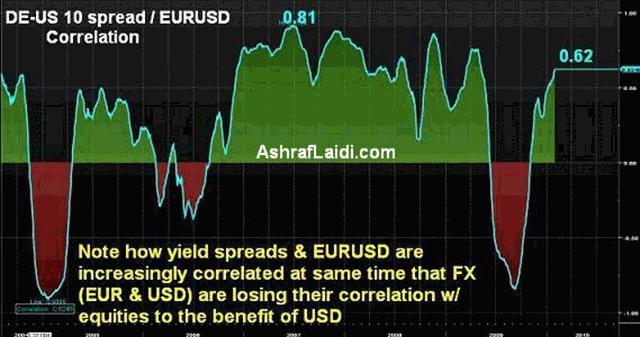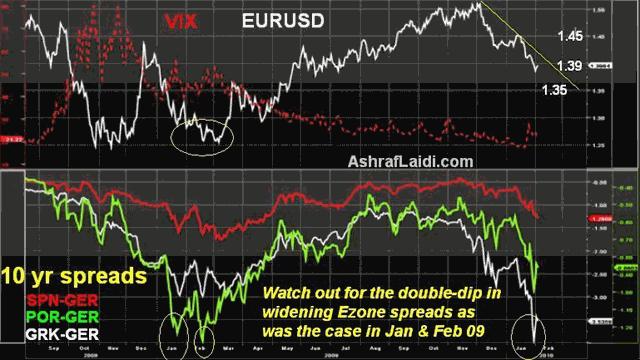$1.32 Euro Under Construction
Ashraf Laidi from CMC Markets at 02/04/10
We pointed out 2 weeks ago that the ongoing decline (weakening) of the once strong inverse correlation between equities and USD would lead to a scenario of prolonged US strength regardless of the evolving trend in equities. As the correlation weakened from a strong -0.94 in November to -0.26 in the 1st week of January, it enabled us to forecast further advances in the greenback irrespective of intraday or daily moves in equities. By taking the other side of the coin and using the daily relation between EURUSD and S&P500, the positive correlation has now fallen from +0.94 in November to a statistically insignificant +0.27 (9-month low).
And as the relationship between FX and equities fades away, the role of yield differentials is strongly back in play, especially for the high profile EURUSD rate. The chart below clearly shows the correlation between German & US 10 year yield spread and EURUSD at an 8-month high of +0.61. Such strong correlation implies that as US yields (now at 3.68%) further gain above their German counterparts (now at 3.22%), the USD dollar strengthens further against EUR, thereby dragging down EURUSD. As markets expect the ECB to maintain rates unchanged (no tightening) and more FOMC members to dissent against the stance of exceptionally low levels of fed funds rate for an extended period, the US yield foundation is expected to further work in favour of the USD against EUR. The $1.38 target issued in January remains intact with a 60% probability of seeing a $1.32 in March
Deepening the analysis into the sovereign spread situation, it is worth noting a possible recurrence of a double-take, similar to that March 2009. The charts in the lower frame below represent the spreads of 10-year yields of selected Eurozone nations over that of Germany (considered the safest bond in the Eurozone). Greek 10 year yields soared to as high as 400 bps above those of Germany, while Portuguese and Spanish yields hit 129 bps and 0.98 bps respectively.
Although all of the spreads have now stabilized--partly due to EUs approval of Greeces debt plan, the risk for fresh jitters remain ample. The EU Commission said it was launching legal proceedings against Greece for unreliable fiscal statistics. As markets keep a close watch on Greece and its interaction with the Commission, the negative FX bias will remains specially that the EU has asked it to reduce its budget deficit to 3% of GDP by 2012 from above 12% today. The Commission will review Greece's progress on March 16, then on May 16,
While Greece and Portuguese debt are stealing the headlines, Spain's fiscal situation also merits focus. 4 months after it projected a 2009 deficit of 5.2% of GDP, Spain issued a new forecast of 11.4% of GDP. Not only data reliability is questionable, but so are any signs of any recovery. This week, Eurozone manufacturing PMI showed its fastest pace in reaching 52.4 in Jan, while Spains own PMI remained adrift in sub-50 territory at 45.3. With unemployment exceeding 4 million, the macroeconomic situation remains an obstacle to any austere fiscal policies.
Incorporating these dynamics with dissenting FOMC members and struggling global indices (have yet to regain their 55-day MAs), the US dollar faces prolonged upside ahead.





